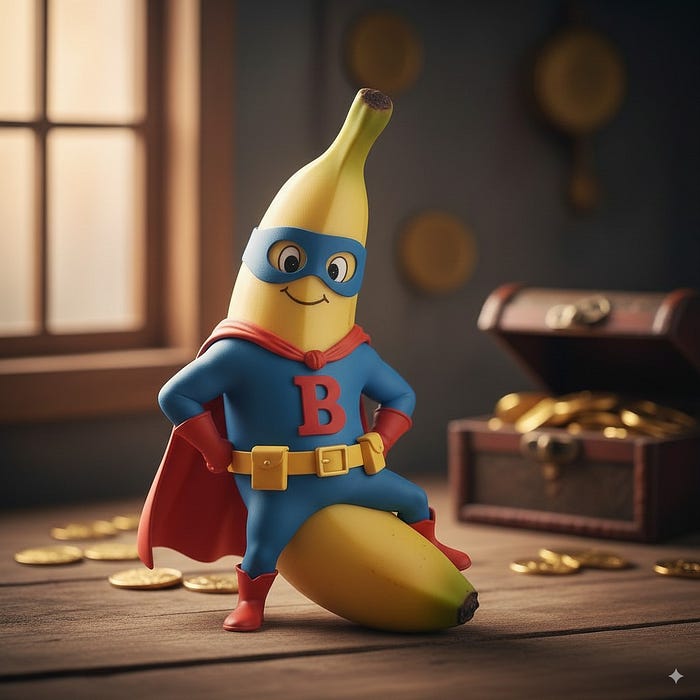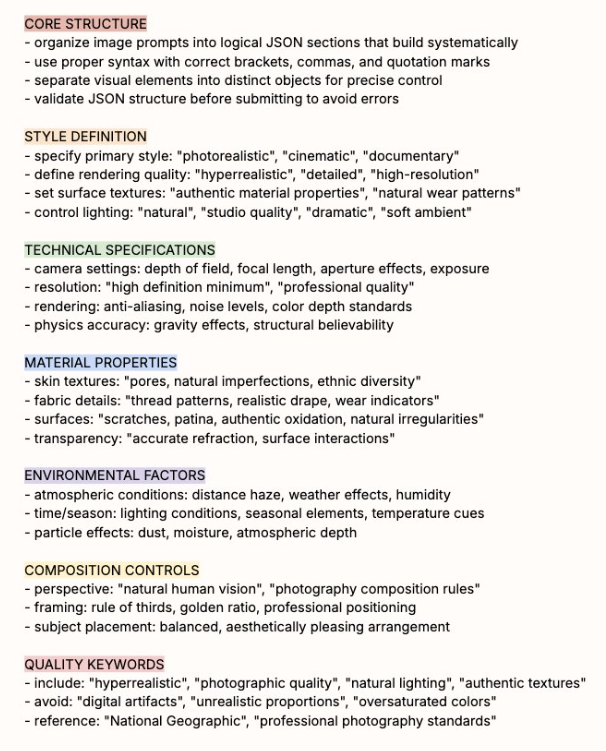Most people just type a long description and hope for the best.
But there's a smarter way: JSON prompts.
Why JSON? Because it's neat.
It organizes your ideas into little boxes.
Instead of dumping everything into one complex line, you split it up.
The model understands it better, and you get cleaner, sharper images.

Start with the Basics
A JSON prompt has a simple skeleton:
{
"style": {},
"technical": {},
"materials": {},
"environment": {},
"composition": {},
"quality": {}
}Think of this as your empty shopping cart. You'll fill it with details one by one.

Style Comes First
This is just: what's the look? Do you want cinematic, documentary, or photorealistic?
"style": {
"primary": "photorealistic",
"rendering_quality": "high-resolution",
"lighting": "natural"
}That line basically says: make it look real, sharp, and naturally lit.
Add Tech Stuff
Suppose You're holding a camera. Depth of field, aperture, exposure — that kind of thing.
"technical": {
"camera_settings": {
"depth_of_field": "shallow",
"focal_length": "85mm",
"aperture": "f/1.8"
},
"resolution": "professional quality"
}No need to overthink this. Just set it up like a photo.
Materials = Real Texture
This part makes things feel real. Skin with pores, fabric with threads, surfaces with scratches.
"materials": {
"skin": "pores, natural imperfections",
"fabric": "thread patterns, realistic drape"
}It's the difference between a fake doll face and a real person.
Set the Scene
Now give your image an environment. Time, season, atmosphere.
"environment": {
"time_season": "autumn sunset",
"atmosphere": "light haze"
}It's those little touches that make the image breathe.
Don't Forget Composition
If you've ever seen a badly framed photo, you know why this matters.
"composition": {
"perspective": "natural human vision",
"framing": "rule of thirds"
}Basically, tell Gemini: don't cut off heads, and follow photography basics.
Quality Check
Last thing — tell it what you want, and what to avoid.
"quality": {
"include": ["hyperrealistic", "natural lighting"],
"avoid": ["oversaturated colors", "digital artifacts"]
}This is like your "do and don't" list.
Full Example
Put it all together and it looks like this:
{
"CORE_STRUCTURE": {
"organization": "Organize image prompts into logical JSON sections that build systematically",
"syntax": "Use proper syntax with correct brackets, commas, and quotation marks",
"visual_elements": "Separate visual elements into distinct objects for precise control",
"validation": "Validate JSON structure before submitting to avoid errors"
},
"STYLE_DEFINITION": {
"primary_style": ["photorealistic", "cinematic", "documentary"],
"rendering_quality": ["hyperrealistic", "detailed", "high-resolution"],
"surface_textures": ["authentic material properties", "natural wear patterns"],
"lighting": ["natural", "studio quality", "dramatic", "soft ambient"]
},
"TECHNICAL_SPECIFICATIONS": {
"camera_settings": ["depth of field", "focal length", "aperture effects", "exposure"],
"resolution": ["high definition minimum", "professional quality"],
"rendering": ["anti-aliasing", "noise levels", "color depth standards"],
"physics_accuracy": ["gravity effects", "structural believability"]
},
"MATERIAL_PROPERTIES": {
"skin_textures": ["pores", "natural imperfections", "ethnic diversity"],
"fabric_details": ["thread patterns", "realistic drape", "wear indicators"],
"surfaces": ["scratches", "patina", "authentic oxidation", "natural irregularities"],
"transparency": ["accurate refraction", "surface interactions"]
},
"ENVIRONMENTAL_FACTORS": {
"atmospheric_conditions": ["distance haze", "weather effects", "humidity"],
"time_season": ["lighting conditions", "seasonal elements", "temperature cues"],
"particle_effects": ["dust", "moisture", "atmospheric depth"]
},
"COMPOSITION_CONTROLS": {
"perspective": ["natural human vision", "photography composition rules"],
"framing": ["rule of thirds", "golden ratio", "professional positioning"],
"subject_placement": ["balanced", "aesthetically pleasing arrangement"]
},
"QUALITY_KEYWORDS": {
"include": ["hyperrealistic", "photographic quality", "natural lighting", "authentic textures"],
"avoid": ["digital artifacts", "unrealistic proportions", "oversaturated colors"],
"reference": ["National Geographic", "professional photography standards"]
}
}You don't need to write perfect prompts. Just break your idea into parts: style, camera, materials, environment, composition, quality. That's it.
Once you start doing this, Gemini Nano Banana stops guessing and starts giving you exactly what you want.
